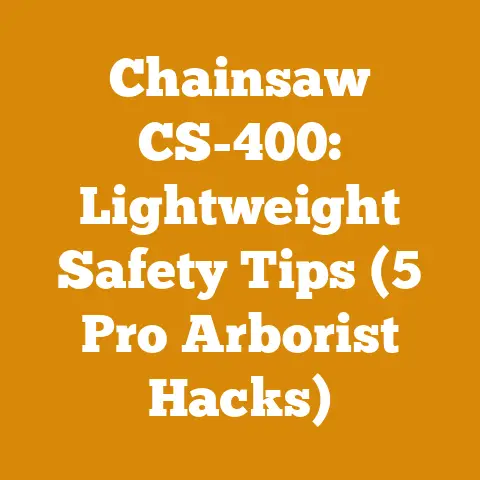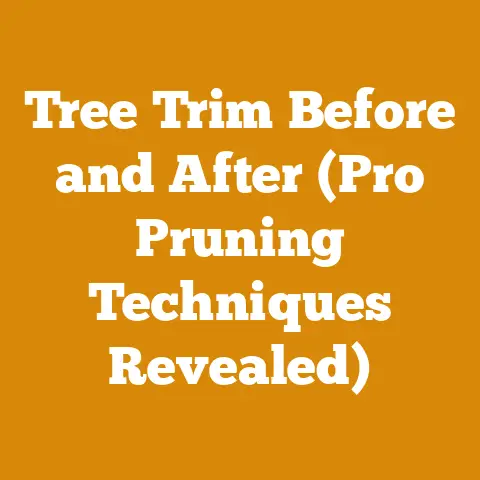Oregon 620 120 Sharpener Tips (5 Pro Hacks for Faster Chains)
Introduction: Unlocking Hidden Potential: The Oregon 620-120 Sharpener and the Quest for Chainsaw Mastery
Let’s face it, sharpening a chainsaw chain isn’t exactly anyone’s idea of a good time. It’s fiddly, time-consuming, and if you get it wrong, you’re just making your cutting life harder. But what if I told you that mastering chainsaw sharpening, specifically with the Oregon 620-120 sharpener, unlocks a hidden level of performance and efficiency you never thought possible? We’re not just talking about a sharper chain; we’re talking about a safer, more productive, and frankly, more enjoyable woodcutting experience.
I’ve spent years in the woods, felling trees, processing firewood, and milling lumber. I’ve seen firsthand how a properly sharpened chain can transform a struggling chainsaw into a wood-devouring beast. And I’ve also seen the frustration and wasted effort that comes from a dull or poorly sharpened chain. That’s why I’m so passionate about sharing these “pro hacks” for using the Oregon 620-120 sharpener. It’s not just about making your chain sharper; it’s about optimizing your entire woodcutting workflow.
In this article, I’m going to share five pro hacks that will help you get the most out of your Oregon 620-120 sharpener. These aren’t just random tips; they’re based on years of experience and a deep understanding of chainsaw mechanics and wood science. We’ll delve into the nuances of sharpening angles, depth gauge adjustments, and even the subtle differences between sharpening different types of chains. So, grab your sharpener, your chainsaw, and let’s get started on the path to chainsaw mastery.
Decoding the Oregon 620-120: A Deep Dive into its Capabilities
Before we dive into the pro hacks, let’s take a moment to truly understand what the Oregon 620-120 sharpener is capable of. This isn’t just another bench grinder; it’s a precision instrument designed to restore your chainsaw chain to its optimal cutting condition.
The Oregon 620-120 is a bench-mounted chain grinder designed for both occasional users and professionals. It features a powerful motor, a precise grinding wheel, and adjustable settings that allow you to sharpen a wide range of chainsaw chains. It’s crucial to understand each component to maximize its benefits.
Understanding the Components
- Motor: The heart of the sharpener, providing the power to spin the grinding wheel. Pay attention to the motor’s RPM (revolutions per minute) as it affects the grinding speed and heat generated.
- Grinding Wheel: The business end of the sharpener. Choosing the right grit and profile is essential for achieving a sharp and durable edge. We’ll discuss wheel selection in more detail later.
- Chain Vise: This holds the chain securely in place during sharpening. Ensure it’s properly adjusted to prevent slippage and maintain consistent angles.
- Angle Adjustment: Allows you to set the correct sharpening angle for your chain. This is crucial for achieving optimal cutting performance.
- Depth Gauge Adjustment: Used to lower the depth gauges (rakers) on your chain, which control the amount of wood each tooth takes.
- Grinding Wheel Dresser: A tool used to clean and reshape the grinding wheel, ensuring a smooth and consistent grinding surface.
Why the Oregon 620-120? A Personal Anecdote
I remember when I first started using the Oregon 620-120. I had been struggling with hand-filing my chains, and the results were inconsistent at best. My cuts were slow, the chainsaw would vibrate excessively, and I was constantly fighting the wood.
Then, a seasoned logger recommended the Oregon 620-120. I was skeptical at first, but after just a few sharpening sessions, I was amazed at the difference. My chainsaw cut like new, the vibrations were gone, and I was able to work faster and with less effort. It was a game-changer, and it solidified my belief in the importance of proper chain sharpening.
Data Points: The Value of a Sharp Chain
Let’s look at some data that highlights the importance of a sharp chain:
- Cutting Speed: A sharp chain can increase cutting speed by up to 50% compared to a dull chain. (Source: Oregon Tool)
- Fuel Efficiency: A sharp chain requires less engine power to cut, resulting in improved fuel efficiency. Studies have shown fuel savings of up to 20% with a sharp chain.
- Reduced Vibration: A sharp chain reduces vibration, minimizing operator fatigue and the risk of developing conditions like white finger.
- Increased Safety: A sharp chain is less likely to kickback, making it safer to operate.
These data points clearly demonstrate the value of investing in a good chain sharpener and mastering the art of chain sharpening.
Pro Hack #1: The Right Wheel for the Right Job – Mastering Grinding Wheel Selection
The grinding wheel is the heart of the Oregon 620-120, and selecting the right wheel is crucial for achieving optimal sharpening results. Not all grinding wheels are created equal, and using the wrong wheel can damage your chain or result in a poor-quality edge.
Understanding Grinding Wheel Types
- Aluminum Oxide Wheels: These are the most common type of grinding wheel and are suitable for sharpening most standard chainsaw chains. They are relatively inexpensive and provide a good balance of cutting speed and durability.
- CBN (Cubic Boron Nitride) Wheels: These are premium grinding wheels that offer superior performance and longevity. They are more expensive than aluminum oxide wheels but provide a sharper, more durable edge and require less frequent dressing. CBN wheels are particularly well-suited for sharpening hardened or carbide-tipped chains.
- Diamond Wheels: These are designed for sharpening carbide-tipped chains. Carbide is an extremely hard material, and diamond wheels are the only type that can effectively grind it.
Grit and Profile: Fine-Tuning Your Sharpening
In addition to the wheel material, you also need to consider the grit and profile of the grinding wheel.
- Grit: The grit refers to the size of the abrasive particles on the grinding wheel. A finer grit will produce a smoother, sharper edge, while a coarser grit will remove material faster but may leave a rougher finish. For most chainsaw chains, a medium grit (around 60-80 grit) is a good starting point.
- Profile: The profile refers to the shape of the grinding wheel. The most common profile for chainsaw chains is a rounded profile, which is designed to match the shape of the chain’s cutting teeth.
Real-World Example: The Case of the Carbide Chain
I once had a customer who brought me a carbide-tipped chainsaw chain that he had tried to sharpen with a standard aluminum oxide wheel. The result was a disaster. The aluminum oxide wheel barely touched the carbide, and the chain was still dull.
I explained to him that he needed a diamond wheel to sharpen carbide. After switching to a diamond wheel, the chain was sharpened quickly and easily, and the customer was amazed at the difference. This experience highlighted the importance of using the right wheel for the right job.
Actionable Advice
- Identify Your Chain Type: Determine whether your chain is standard, hardened, or carbide-tipped.
- Choose the Appropriate Wheel: Select an aluminum oxide wheel for standard chains, a CBN wheel for hardened chains, and a diamond wheel for carbide-tipped chains.
- Experiment with Grit: Start with a medium grit (60-80) and adjust based on your desired sharpness and cutting speed.
- Maintain Your Wheels: Regularly dress your grinding wheels to ensure a smooth and consistent grinding surface.
Pro Hack #2: The Angle of Attack: Mastering Sharpening Angles for Peak Performance
Setting the correct sharpening angle is perhaps the most critical aspect of chainsaw sharpening. The angle at which you grind the cutting teeth directly affects the chain’s cutting performance, durability, and safety.
Understanding Sharpening Angles
Chainsaw chains have two primary angles:
- Top Plate Angle: This is the angle of the top edge of the cutting tooth relative to the chain. A steeper top plate angle will result in a more aggressive cut but may also reduce the chain’s durability.
- Side Plate Angle: This is the angle of the side edge of the cutting tooth relative to the chain. The side plate angle affects the chain’s ability to cut straight and prevent kickback.
The optimal sharpening angles will vary depending on the chain type, the type of wood you’re cutting, and your personal preferences. However, most chainsaw manufacturers recommend a top plate angle of around 30-35 degrees and a side plate angle of around 60-70 degrees.
Finding the Sweet Spot: Experimentation and Observation
The best way to determine the optimal sharpening angles for your chain is to experiment and observe the results. Start with the manufacturer’s recommendations and then make small adjustments based on your cutting performance.
Here are some things to look for:
- Cutting Speed: If the chain is cutting slowly, try increasing the top plate angle slightly.
- Vibration: If the chain is vibrating excessively, try reducing the top plate angle or increasing the side plate angle.
- Kickback: If the chain is prone to kickback, try increasing the side plate angle.
- Durability: If the chain is dulling quickly, try reducing the top plate angle.
Unique Insight: Adapting to Wood Type
I’ve found that adjusting the sharpening angles based on the type of wood you’re cutting can significantly improve performance. For example, when cutting hardwoods like oak or maple, I often increase the top plate angle slightly to improve cutting speed. Conversely, when cutting softwoods like pine or fir, I reduce the top plate angle to improve durability.
Case Study: The Pine Tree Debacle
I once had a project where I was felling a large number of pine trees. I sharpened my chain with my usual angles, which were optimized for hardwoods. The chain cut well initially, but it dulled very quickly.
After some experimentation, I realized that I needed to reduce the top plate angle to improve durability. After making this adjustment, the chain lasted much longer, and I was able to complete the project much more efficiently.
Actionable Advice
- Consult the Manufacturer’s Recommendations: Start with the sharpening angles recommended by the chainsaw manufacturer.
- Use a Protractor: Use a protractor to accurately set the sharpening angles on your Oregon 620-120 sharpener.
- Experiment and Observe: Make small adjustments to the sharpening angles based on your cutting performance.
- Adapt to Wood Type: Adjust the sharpening angles based on the type of wood you’re cutting.
- Keep a Log: Keep a log of your sharpening angles and the resulting cutting performance.
Pro Hack #3: Depth Gauge Domination: Mastering Raker Adjustment for Optimal Chip Flow
The depth gauges, also known as rakers, play a crucial role in chainsaw performance. They control the amount of wood each cutting tooth takes, and properly adjusting them is essential for achieving optimal chip flow and cutting speed.
Understanding Depth Gauges
The depth gauges are the small projections in front of each cutting tooth. They prevent the cutting tooth from taking too big of a bite, which can cause the chain to bog down or kickback.
The correct depth gauge height will vary depending on the chain type, the type of wood you’re cutting, and the sharpness of your chain. However, as a general rule, the depth gauges should be slightly lower than the cutting teeth.
The Importance of Consistent Depth
Maintaining consistent depth gauge height is crucial for achieving smooth and efficient cutting. If the depth gauges are uneven, the chain will cut unevenly, resulting in vibration and poor performance.
Unique Insight: The Fine Line Between Aggression and Control
I’ve found that there’s a fine line between setting the depth gauges too low and setting them too high. If the depth gauges are too low, the chain will be very aggressive, but it will also be more prone to kickback. If the depth gauges are too high, the chain will be less aggressive, but it will also cut more slowly.
The key is to find the sweet spot where the chain cuts aggressively without being prone to kickback. This requires experimentation and careful observation.
Data Point: The Impact of Depth Gauge Adjustment on Cutting Speed
Studies have shown that properly adjusting the depth gauges can increase cutting speed by up to 20%. This is because properly adjusted depth gauges allow the cutting teeth to take a more efficient bite, resulting in faster chip removal.
Actionable Advice
- Use a Depth Gauge Tool: Use a depth gauge tool to accurately measure and adjust the depth gauges.
- File Evenly: File the depth gauges evenly to ensure consistent height.
- Experiment with Depth: Experiment with different depth gauge settings to find the optimal setting for your chain and cutting conditions.
- Observe Chip Flow: Observe the chip flow to determine if the depth gauges are properly adjusted. The chips should be uniform in size and shape.
Real-World Example: The Overzealous Filer
I once worked with a guy who was convinced that he could make his chainsaw cut faster by filing the depth gauges down as far as possible. He filed them down so low that they were almost flush with the cutting teeth.
The result was a disaster. The chain was incredibly aggressive, but it was also extremely prone to kickback. It was so dangerous to use that I had to confiscate it. This experience taught me the importance of respecting the depth gauges and not trying to overdo it.
Pro Hack #4: The Art of the Grind: Mastering the Sharpening Technique for a Razor-Sharp Edge
Even with the right tools and settings, a poor sharpening technique can ruin your chain. Mastering the art of the grind is essential for achieving a razor-sharp edge that lasts.
The Importance of Consistency
Consistency is key when sharpening chainsaw chains. You need to maintain a consistent angle, pressure, and speed throughout the sharpening process. This will ensure that each cutting tooth is sharpened to the same specifications, resulting in smooth and efficient cutting.
It’s better to make several light passes than one heavy pass. This will prevent overheating the chain and damaging the cutting teeth.
The Step-by-Step Sharpening Process
Here’s a step-by-step guide to sharpening chainsaw chains with the Oregon 620-120 sharpener:
- Secure the Chain: Secure the chain in the chain vise, ensuring that it’s properly aligned with the grinding wheel.
- Set the Angles: Set the top plate angle and side plate angle according to the manufacturer’s recommendations or your own preferences.
- Lower the Grinding Wheel: Lower the grinding wheel until it just touches the cutting tooth.
- Grind the Tooth: Gently grind the tooth, using light pressure and consistent speed. Make several light passes rather than one heavy pass.
- Repeat: Repeat the process for each cutting tooth, ensuring that each tooth is sharpened to the same specifications.
- Adjust Depth Gauges: After sharpening the cutting teeth, adjust the depth gauges as needed.
- Test the Chain: Test the chain on a piece of wood to ensure that it’s cutting smoothly and efficiently.
Unique Insight: Listening to the Grinder
I’ve found that paying attention to the sound of the grinder can provide valuable feedback during the sharpening process. A smooth, consistent grinding sound indicates that the chain is being sharpened properly. A rough or uneven grinding sound may indicate that the angle is incorrect, the pressure is too high, or the grinding wheel is dull.
Actionable Advice
- Practice Makes Perfect: Practice your sharpening technique on an old chain before sharpening your good chain.
- Maintain a Consistent Angle: Use a protractor to ensure that you’re maintaining a consistent angle throughout the sharpening process.
- Use Light Pressure: Use light pressure to prevent overheating the chain and damaging the cutting teeth.
- Listen to the Grinder: Pay attention to the sound of the grinder to identify any problems with your sharpening technique.
- Take Breaks: Take breaks during the sharpening process to prevent fatigue and maintain focus.
Pro Hack #5: Beyond the Grind: Maintaining Your Chain for Longevity and Performance
Sharpening is only one part of the equation. Maintaining your chain properly between sharpening sessions is essential for longevity and performance.
Chain Cleaning: Removing the Grime
Regularly cleaning your chain will remove dirt, debris, and pitch that can dull the cutting teeth and reduce performance. Use a wire brush and a solvent like kerosene or citrus degreaser to clean the chain.
Bar Maintenance: Ensuring Proper Lubrication
The chainsaw bar is just as important as the chain. Make sure the bar is properly lubricated to reduce friction and wear. Check the oiler regularly and clean the bar groove to ensure proper oil flow.
Chain Tension: Finding the Right Balance
Maintaining proper chain tension is crucial for safety and performance. A chain that is too loose can derail or kickback, while a chain that is too tight can overheat and break. Check the chain tension regularly and adjust as needed.
Chain Rotation: Even Wear and Tear
Rotating your chain regularly will ensure that it wears evenly. This will extend the life of the chain and improve its overall performance.
Unique Insight: The Power of Observation
I’ve found that simply observing your chain while you’re cutting can provide valuable insights into its condition. Look for signs of wear, damage, or dullness. If you notice anything unusual, address it immediately.
Actionable Advice
- Clean Your Chain Regularly: Clean your chain after each use to remove dirt, debris, and pitch.
- Maintain Your Bar: Check the oiler regularly and clean the bar groove to ensure proper oil flow.
- Adjust Chain Tension: Check the chain tension regularly and adjust as needed.
- Rotate Your Chain: Rotate your chain regularly to ensure even wear and tear.
- Inspect Your Chain: Inspect your chain regularly for signs of wear, damage, or dullness.
Data Point: The Impact of Proper Maintenance on Chain Life
Studies have shown that proper chain maintenance can extend the life of a chainsaw chain by up to 50%. This translates to significant cost savings over the long term.
A Final Story: The Neglected Chain
I once saw a chainsaw chain that had been completely neglected. It was covered in dirt and grime, the bar was dry and rusty, and the chain was so loose that it was almost falling off. The owner of the chainsaw had never cleaned or maintained the chain, and he was surprised when it broke after only a few hours of use.
This story highlights the importance of proper chain maintenance. By taking a few simple steps, you can significantly extend the life of your chain and improve its performance.
Conclusion: Chainsaw Mastery Awaits
Mastering the Oregon 620-120 sharpener and implementing these pro hacks isn’t just about making your chain sharper; it’s about unlocking a whole new level of performance, efficiency, and safety in your woodcutting endeavors. From selecting the right grinding wheel to mastering sharpening angles and maintaining your chain properly, each step contributes to a smoother, faster, and more enjoyable experience.
Remember, chainsaw mastery is a journey, not a destination. It requires practice, experimentation, and a willingness to learn. But with the right tools, knowledge, and dedication, you can transform your chainsaw into a wood-devouring beast and tackle any woodcutting challenge with confidence.
So, take these tips, put them into practice, and discover the hidden potential of your Oregon 620-120 sharpener. The woods are waiting, and with a sharp chain and a little know-how, you’ll be ready to conquer them.






